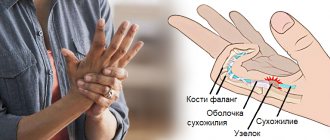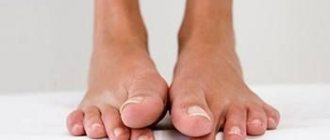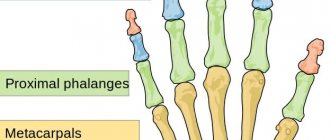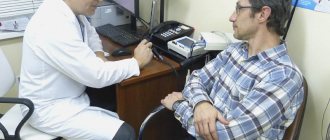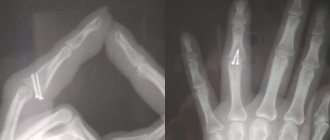Syndactyly - a congenital anomaly of the development of fingers or toes, which is a complete or partial fusion of two or more fingers. Sometimes the disease is complicated by their deformation and underdevelopment (the nail bed or phalanx may be absent).
The cause of syndactyly is an anomaly in the embryonic period of bone formation during pregnancy. The disease is diagnosed in one baby out of 2,500 newborns, and boys suffer from this disease almost twice as often as girls. Every second baby with syndactyly is diagnosed with additional skeletal developmental anomalies (hypoplasia of the fingers, flat feet, foot deformity, etc.).
The main consequence of syndactyly is a cosmetic defect that can be eliminated in the only way - surgical separation of the fingers. In this case, it is possible to perform partial plastic surgery to restore missing tissue.
Lack of timely treatment for syndactyly can cause irreversible consequences in the development of the child’s limbs, his mental and intellectual development.
Types of disease
In medicine, there are several types of classification of the disease, all of them are given below.
According to the time of occurrence, syndactyly is divided into:
- congenital;
- acquired.
Based on the type of digital fusion, orthopedists distinguish the following types:
- soft tissue syndactyly: a) membranous - a thin partition of skin between the fingers; b) skin - between the fingers there is a thick membrane consisting of soft tissues and skin folds;
- bone - adhesions of bones are detected along one or several phalanges at the same time.
Based on the length of the fusion, doctors distinguish:
- full type - when all phalanges are connected, including the nail ones;
- partial (or incomplete) type - not all phalanges are connected: a) incomplete basal - fusion of the first two phalanges; b) terminal – fusion of only the nail phalanges.
Based on the condition of the fingers, the following types are distinguished:
- simple syndactyly - fingers are normally developed and function well;
- complex form - there are anomalies in the development of ligaments, tendons and fusion of bone tissue with the impossibility of normal flexion.
Genetic types of disease:
- Type 1 (zygodactyly) – fusion of the 3rd and 4th fingers on the hand, 2nd and 3rd on the foot;
- Type 2 (synpolydactyly) – fusion of the 3rd and 4th fingers on the hand, doubling of the 4th finger, or fusion of the 4th and 5th toes with doubling of the little finger, the relief is disturbed;
- Type 3 – bilateral fusion of the 4th and 5th fingers, the little finger is underdeveloped;
- Type 4 (Gaza syndactyly) – complete syndactyly of all fingers on both hands, spoon-shaped hands;
- Type 5 – syndactyly with fusion of the metatarsal and metacarpal bones, found on both the feet and hands.
Reasons for the development of the disease
Factors that disrupt the normal process of development of a child’s limb during the prenatal period are:
- autosomal dominant heredity (the most common cause of complex forms of the disease);
- the mother is taking heavy medications (for example, antibiotics);
- maternal smoking and alcoholism;
- poor environmental conditions in the place of residence;
- difficult working conditions;
- irradiation of the expectant mother with x-rays;
- transference of severe infectious diseases during pregnancy (pulmonary tuberculosis, syphilis, some forms of influenza, mumps);
- gene mutations (Poland syndrome, Edwards syndrome, Apert syndrome).
The causes of acquired syndactyly are considered to be:
- thermal burn (boiling water, hot steam);
- chemical burn.
In some cases, the cause of syndactyly in an infant remains unknown.
1.General information
The term “syndactyly” translated from Latin means a joint, combined position of the fingers or, more simply, fused fingers. This is a congenital pathology, which has many varieties, occurs under the influence of various factors and, according to statistics, occurs with an ever-increasing frequency. In different regions of the world, syndactyly is detected in 0.02% -2% of newborns.
According to some sources, the likelihood of such an anomaly does not depend on gender; according to others, it is higher in boys. Syndactyly on the legs is much less common than on the hands. Often, fused fingers are not the only anomaly of intrauterine development and are observed in combination with other developmental defects, for example, the musculoskeletal system. And syndactyly is always eliminated (if elimination is at all possible) by microsurgical intervention.
A must read! Help with treatment and hospitalization!
Surgical treatment
Syndactyly is treated only with surgical methods, most often on the fingers. Separation of the toes is indicated only in cases of inconvenience when walking and obstruction of the normal development of the leg.
The best age for surgery to separate fused fingers is considered to be between 4 and 5 years. With the end (terminal) type of syndactyly, surgical intervention is recommended to be performed at the age of 6-12 months, which is associated with a high probability of repeated deformation of the fingers during their growth.
Due to the age of the children, they are given general anesthesia (complete immobility is required). The duration of the operation depends entirely on the complexity of the case and can range from 30-40 minutes to 3-4 hours.
Types of surgical approaches during surgery:
- simple dissection of the skin membrane;
- dissection of the membrane with the need for plastic surgery with one’s own tissues;
- dissection of the membrane with the need for plastic surgery with local tissues and autografts;
- complex operations requiring muscle, tendon and bone grafting.
2. Reasons
Acquired syndactyly is possible only as a result of a burn or chemical “fusion” - and is much less common than congenital forms. The main etiological cause of congenital syndactyly is heredity, burdened by the same or other similar anomalies. However, one cannot discount reliably established and confirmed risk factors, which provide alarming dynamics in the incidence of congenital defects of limb development:
- environmental hazards, incl. mother's work in hazardous industries;
- intoxication during the gestational period: alcohol, smoking, taking medications, etc.;
- radiation injuries.
Visit our Microsurgery page
Postoperative period
Immediately after recovery from anesthesia, the surgeon applies a removable plaster splint designed to immobilize the fingers on the operated limb. You need to wear it for 2-4 months.
In special cases, it may be necessary to additionally wear a finger spacer to prevent re-fusion of the sutures.
In the first few days after surgery, the baby requires special care (regular changes of bandages, application of healing ointments to the wound) and medications (antibiotics, painkillers).
4 weeks after surgery, after the wound has healed, you can begin a course of restorative treatment aimed at normalizing the functioning of the limb:
- massage of the limb by a specialist to improve tone;
- Exercise therapy with a trainer;
- ultraphonophoresis;
- electrical stimulation of muscles;
- applications on limbs of mud, paraffin, ozokerite.
3. Symptoms and diagnosis
Syndactyly can be simple (fusion of normal soft tissues, membranous junction or common skin sheath) or complex when there is common bone tissue, undivided nails, and associated structural defects of the hand or foot. At the stage of intrauterine formation, two or more fingers may not separate.
Fused toes are diagnosed during a neonatal examination at birth. In some cases, syndactyly can be visualized already during intrauterine ultrasound, especially if there are grounds for suspicion and the study is carried out purposefully. To clarify the situation, additional diagnostic tests (x-rays, etc.) are prescribed.
About our clinic Chistye Prudy metro station Medintercom page!
Is it possible to recognize syndactyly on your own?
Yes it is possible. Syndactyly is clearly visible to the naked eye. The neonatologist makes a preliminary diagnosis after the initial examination of the child. Further diagnostics will be carried out to clarify the type of syndactyly.
X-ray examination is the simplest and most informative procedure. X-rays will show whether the fingers are connected only by skin and soft tissue, or whether bones are also involved. In more severe cases, an MRI or CT scan may be required. Tomography provides more detailed information about the structure of the bones.
In some cases, signs of syndactyly are detected in utero, during mandatory ultrasound screening examinations during pregnancy. The skin bridges between the toes usually disappear before the 56th day of pregnancy. Their detection at a later date indicates syndactyly.
Surgery for syndactyly in Moscow
The Department of Pediatric Surgery at CELT invites you to undergo surgery for syndactyly of fingers and toes in Moscow. We have been working in the domestic market of paid medical services for more than twenty-five years and provide treatment and diagnostics in accordance with international standards.
Your child will be cared for by experienced pediatric surgeons with the highest qualification category. They have decades of experience and hundreds of successfully completed operations behind them. Good knowledge of child psychology allows them to quickly find a common language with young patients. The correct attitude of the baby plays an important role, as it affects the outcome of the operation.
Surgery for syndactyly of the legs and arms is preceded by a thorough diagnosis. Our multidisciplinary clinic has a powerful diagnostic base that allows us to conduct comprehensive studies, identify contraindications, determine the scope of intervention and draw up a plan. The process uses special anesthetic drugs designed specifically for the child’s body. They do not harm it, but at the same time provide the desired effect, eliminating any pain or discomfort.
The cost of surgery for syndactyly is calculated individually, taking into account the complexity of the case and the technique used. You can find out the exact numbers from your doctor after consultation and diagnosis. Preliminary figures are presented in the “Services and Prices” tab in this section of our official website. We regularly update price lists, although in order to avoid misunderstandings, we still ask you to check the numbers with our operators: +7 (495) 788-33-88.
Indications for surgery for syndactyly of the toes and hands
A patient with syndactyly of the upper limbs experiences psychological discomfort due to a cosmetic defect. He may complain of feeling inferior, experience a lack of communication and self-confidence. In addition, the disease limits normal movements not only of the fingers, but of the entire limb. As a result, the child lags behind in development, his psychomotor, intellectual, and speech abilities are inhibited, which impedes learning and does not allow normal self-realization in the future.
As for syndactyly of the legs, there is discomfort here too. Although the defect can be hidden with shoes, there are a number of areas in which sufferers of this disease feel inferior. They refuse to visit gyms and swimming pools, saunas and beaches. At the same time, an abnormality of the toes is quite rarely complicated by functional disorders, so most often the reason for visiting a doctor is the patient’s desire to eliminate a cosmetic defect.
In a simple form, surgery is indicated at the age of one to two years, in a complex form - from five months to one year. Such an earlier procedure will eliminate the lag in general development and the development of complications in the form of secondary deformities.
Is it necessary to visit a doctor regularly after treatment?
Yes, you will need to visit the clinic regularly for the first few months. Immediately after surgery, the arm will be protected with a voluminous soft bandage covering the arm and forearm. An additional rubber pad may be placed between the affected toes to prevent recurrence of syndactyly while the wound is healing.
One of the main tasks of the postoperative period is the prevention of scar formation. During the healing process, the skin may be replaced by connective tissue. Connective tissue effectively and quickly covers the surface of the wound, but cannot stretch. Thus, the fingers lose their normal shape and function. In such cases, a repeat operation is performed.
In specialized clinics abroad, physiotherapy is mandatory during rehabilitation. It helps to avoid stiffness and swelling and restore normal range of motion. All procedures are performed under the strict supervision of a qualified medical professional.
Send a request for treatment
FRONT FINGERS OR SYNDACTYLY: ALL ABOUT THE IMPORTANT
Today we’ll talk about a disease called syndactyly.
WHAT IS SYNDACTYLY? Syndactyly is a congenital fusion of two or more fingers on the hands or feet. The key feature of this pathology is that the fingers or toes become fused. The disease can be present on one or several limbs. In addition, syndactyly of the arm or leg may be accompanied by other deformities of the limb associated with improper development of the joints. STATISTICS Syndactyly accounts for about 50% of congenital anomalies of the upper limbs. According to statistics, pathology occurs in 10% of newborns. In girls, the pathology is less common than in boys, since very often the mutating gene is transmitted through the male line. WHEN DOES PATHOLOGY APPEAR? The pathology manifests itself at 4-8 weeks of pregnancy, when the embryo begins to lay and form the hand. This developmental defect accounts for more than half of all anomalies of the hands and feet. TYPES OF SYNDACTYLY Syndactyly on the legs, as well as on the arms, is of two types depending on the type of fusion:
- Soft tissue form
, in which only soft tissues grow together, while the bones can fully develop. - Bone form
, in which the fusion of the fingers of the bone form is complicated by the fact that there is a partial or complete fusion of the bones of the phalanges.
WHAT ARE THE CAUSES OF THE DISEASE? The main cause of syndactyly is a hereditary factor that is transmitted in an autosomal dominant manner. However, if there were no cases of syndactyly in the family, then the cause of the anomaly lies in the unfavorable course of pregnancy, provoked by negative factors, such as:
- taking medications,
- alcohol,
- ecology,
- work in hazardous industries,
- x-ray irradiation,
- infectious diseases during pregnancy.
Very often, the reasons for the formation of syndactyly remain unclear. SYMPTOMATICS OF SYNDACTYLY The main symptom of syndactyly is the presence of fused fingers, which is obvious at the first examination of a newborn child. The shape and type of fusion can be different, depending on whether the fusion is soft tissue or bone, complete or incomplete, with deformation of the fused fingers or not. With bilateral syndactyly, as a rule, symmetrical fusion is observed. With soft tissue fusion, the functions of the hand are practically not impaired, which allows children with this type of pathology to perform a fairly wide range of actions. But still, limitations in performing various actions with the fingers can hinder the harmonious development of the child, complicate the learning process and inhibit psychomotor, mental and speech development. WHAT ARE THE METHODS FOR DIAGNOSIS OF THIS PATHOLOGY? The diagnosis of syndactyly is established immediately after birth based on an external examination of the child. To accurately determine the form of the defect and select the most appropriate treatment tactics, a number of studies are carried out:
- Doppler ultrasound;
- radiography;
- rheovasography;
- angiography;
- electrothermometry.
Also, to exclude chromosomal and gene abnormalities, consultation with a geneticist is recommended. WHAT DOCTOR TREATS THIS DISEASE? Treatment of syndactyly is usually carried out: at the diagnostic stage - by a neonatologist, at the treatment stage - by a surgeon and pediatric orthopedist. TYPES OF SYNDACTYLY Typification of syndactyly is carried out: by form and structure.
In particular,
according to the form of the disease, 5 types of syndactyly are distinguished:
- Type 1 (zygodactyly): complete or partial membranous fusion of the middle and ring fingers, or the second and third toes. Possible webbing between other fingers;
- Type 2 (synpolydactyly): fusion of the middle and ring fingers and simultaneous doubling of the ring finger; fusion of the fourth and fifth toes with duplication of the little toe;
- Type 3: complete bilateral fusion of the ring finger and little finger, shortening of the little finger due to an undeveloped or absent middle phalanx;
- type 4 (Haas type): complete bilateral skin fusion, as a result of which the hand becomes spoon-shaped;
- Type 5 is characterized by the complication of syndactyly by synostosis of the metacarpal and metatarsal bones, mainly observed between the ring and middle fingers of the hand, and on the legs - between the second and third.
Based on their structure, there are 4 types of syndactyly:
- bone, in which there are bone adhesions of the fingers;
- cutaneous syndactyly - the connection of the fingers with a soft membrane, often running along the entire length;
- terminal, in which the ends of the phalanges of the fingers are fused;
- cutaneous membranous syndactyly - the connection of the fingers by a small skin bridge.
TREATMENT OF SYNDACTYLY Treatment of syndactyly is carried out through surgery. In cases of fusion of the toes, surgery is performed only if the pathology interferes with walking. The method that will be used to perform the operation and the time of its implementation are determined depending on the form of the pathology and its nature. The most suitable age for surgery is 4-5 years. In cases with terminal syndactyly, surgery is performed between 6 and 12 months of age to prevent uneven growth and secondary deformation of the fingers. METHODS OF OPERATION There are five methods of operation, the most complex of which is a multi-stage intervention, in which, in addition to separation, bone, muscle, tendon and skin plastic surgery is performed. The simplest intervention is to separate the membrane, which does not require plastic surgery. For 3-4 months after surgery, a removable plaster splint is applied to the hand. Two weeks after the operation, physiotherapeutic procedures begin:
- physiotherapy;
- massage;
- ultraphonophoresis;
- ozokerite, paraffin or mud applications.
It is important to note that in the vast majority of cases, the simple (cutaneous) form of toe syndactyly does not cause functional problems. The main indication for surgery is aesthetic dissatisfaction with the appearance of the foot. Which naturally prevails in female patients, since in women the foot, like the hand and face, is an aesthetically significant part of the body, which is often not covered by clothes or shoes. Therefore, the main issue that must be resolved by the patient before choosing to undergo surgery or refuse it is the issue of quality of life. FOLK SIGNS Our ancestors believed that any deformation of the foot is a sign. The signs of fused toes were also noticeable. Moreover, they had two completely opposite interpretations on this matter.
- Because in ancient times, any deformation of the foot was considered an ominous sign, bringing misfortune not only to the patient and his loved ones, but also to the entire environment. It was believed that such people sow spiritual and emotional destruction around themselves. For a boy, fused toes on the right foot were considered a particularly unlucky sign, and for a girl, on the left. If the phenomenon was observed on both limbs, then everyone was sure that the child was possessed by evil spirits.
- Another interpretation, on the contrary, endowed people with fused fingers with extraordinary mystical abilities and special protection from higher powers. It was believed that children with such characteristics have special talents in many areas from the exact sciences to various types of arts.
FAMOUS PEOPLE WITH SYNDACTYLY Among the people suffering from this disease, there are famous personalities. For example, Stalin's second and third toes on his left foot were fused from birth. American actor Ashton Kutcher also suffers from this disease, who is not at all embarrassed by it, and even periodically shows off his fused fingers on camera. If you or your child suffers from this disease, our clinic will be happy to help you solve this problem and live a full life! Your Ladisten Clinic.
Organization of treatment in leading foreign clinics
If you want plastic correction of your child’s fused fingers to be performed in Germany, you need to resolve a number of issues. The first is to choose the most suitable clinic and obtain permission for treatment there. Treating children is a big responsibility, and not all clinics and doctors are ready to accept it. You should also take care of all medical and administrative documents related to traveling abroad for treatment. Please pay attention to the translation of documentation - medical reports must be in German. After this, you can begin to find an interpreter who will accompany you in the clinic.
You can undergo surgery to restore the appearance and function of the hand at the Helios Clinic Berlin-Buch. The Department of Pediatric Surgery, under the direction of Prof. Dr. med. Klaus Schaarschmidt, successfully performs operations on young children with all types of congenital hand defects. The pediatric surgeons of the department remove additional phalanges and fingers for polydactyly types I-VII, and separate fused fingers for syndactyly. If necessary, skin grafting from the thigh or forearm is also performed - this allows you to completely restore the function of the hand and prevent the development of postoperative contracture as the child grows.
Considering that hand pathologies are often found in complex genetic disorders, the department’s specialists pay special attention to a comprehensive examination, involving specialists in related fields in this process. As a rule, hand surgeries are performed in a hospital setting. For the convenience of parents and children, the clinic offers a Rooming-in placement system, when a small patient and one of his parents are located in the same room.
An easier and more convenient way to organize treatment is to use the professional help of Booking Health. Booking Health is a certified medical tourism operator that organizes treatment abroad for children and adults from 75 countries. Booking Health doctors and coordinators will assist you in the following matters:
- Choosing the right clinic for your child
- Communication with a doctor, agreement on a preliminary treatment plan
- Providing favorable cost of treatment, without surcharges and coefficients for foreign patients (savings up to 50%)
- Sign up for surgery on the desired date
- Additional independent control of the treatment program
- Communication with the clinic after completion of treatment, organization of follow-up examinations and remote consultations
- Strict control of accounts and return of unspent funds
- Booking accommodation and air tickets, organizing transfers
- Translation services
In addition, your personal medical coordinator will stay in touch with you 24 hours a day. You will feel confident and protected while treating your child.
